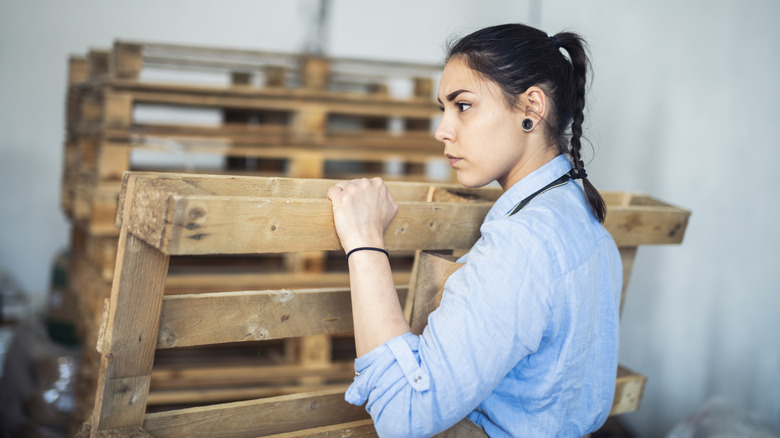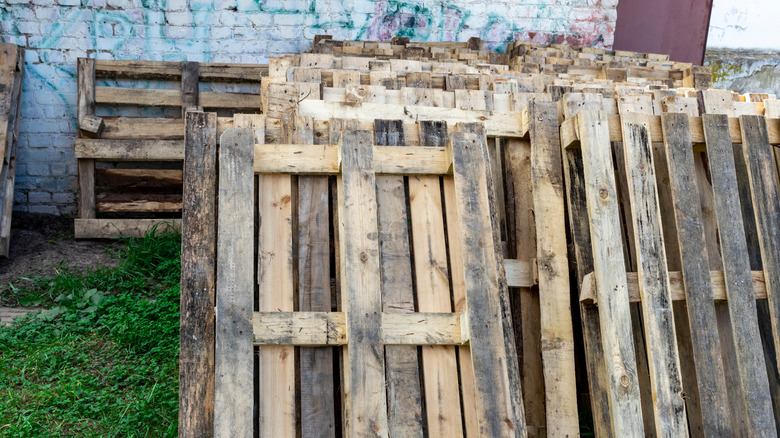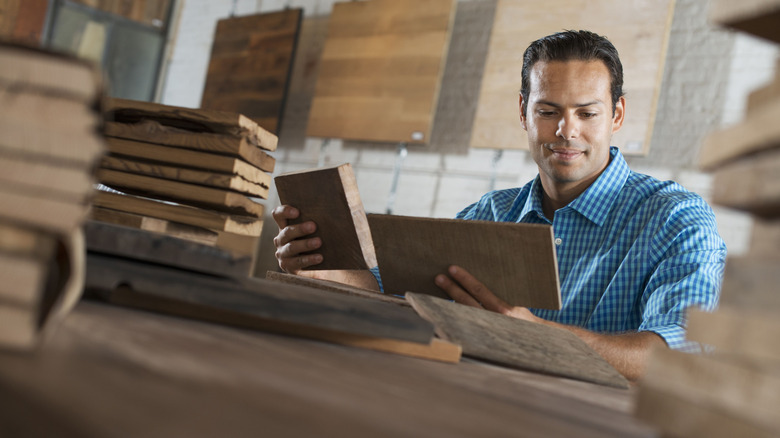Why Some People Say You Shouldn't Use Wood Pallets (And Alternatives To Try)
Wood pallets might seem like the perfect DIY material, especially if you already have some around the house, but they're not always as safe as you might think. Depending on where they came from and what they were used to carry, pallets can harbor hidden hazards like toxic chemicals, bacteria, or mold. That's why more and more people are raising concerns, especially when it comes to using them for projects like indoor furniture, edible plants, or anything that involves kids or pets.
Still, it's easy to see why pallets are so popular. They're cheap or even free, relatively easy to find, and offer a rustic, upcycled look that fits perfectly with today's sustainable DIY movement. Whether you're reusing wooden pallets for the perfect garden spacing, creating deck chairs, or even building a simple coffee table, pallets can be transformed into just about anything. Do a quick search for pallet projects, and you'll be rewarded with a smorgasbord of creative builds showing how leftover shipping wood has been magically transformed into home upgrades. But before jumping on that bandwagon, it's worth knowing the risks — and what the safer alternatives are.
The hidden risks of wood pallets (and how to use them safely)
Wood pallets are often treated to prevent pests or mold. Some — especially older ones — may carry traces of methyl bromide, a toxic pesticide that's now banned in many countries but can still show up on secondhand pallets. Even heat-treated pallets, which are considered safer than chemical-treated wood, can soak up oil, bacteria, and other contaminants during transport. Since you don't always know what a pallet was used for or where it has been stored, it's hard to guarantee it's safe to use. That's especially a concern if you're using the pallet wood for food-related projects or furniture.
If you've got your heart set on using wood pallets, there are a few precautions that can make them safer. Look for the heat-treated "HT" stamp, and steer clear of pallets marked "MB" or those without any stamp at all. Also, choose pallets that were used for dry goods, ideally from local businesses where you can quiz someone about the pallet's origin. However, pallets are often reused by multiple companies, so it's possible that they had a different use before landing at a local business.
One you secure a safe option, you'll need to clean your wood pallet before starting on your DIY. Begin by removing the surface dirt with a strong brush. Next, use hot, soapy water to scrub off the stubborn bits. Finally, you'll need to sanitize the pallet. You can do this with a bleach mix or vinegar solution. Allow it to dry out fully (preferably in the sun), and then sand any rough patches to smooth out splinters and get rid of any lingering mold.
Safer alternatives to wood pallets for DIY projects
If you're after that reclaimed, eco-friendly aesthetic but want to avoid the risks that come with pallet wood, there are plenty of safer alternatives to try. Reclaimed wood from known sources, such as deconstructed barns, old furniture, or hardwood flooring, is a great option. You'll still get the charm and character of aged wood but without the mystery stains or chemical exposure synonymous with pallets. There are plenty of places to look for this kind of material, both online and in person. Look for local businesses that sell reclaimed wood, keep an eye on Facebook Marketplace, and check secondhand stores like Habitat for Humanity ReStore. However, there are still some risks with older wood, such as the presence of lead paint. If you use old barn wood, it could possibly have animal pathogens on it.
Another option is to use new, untreated wood like pine or cedar. That works especially well for functional outdoor projects like building a frame for a bin so you can make your own DIY compost. New wood may not have the worn-in look right away, but it's much easier to work with and won't come with any unpleasant surprises. For projects where structural support is key — like raised platforms or storage bases — plastic or composite pallets can offer a cleaner, splinter-free solution. They're often made from recycled materials and can be reused multiple times without degrading.
You can also get creative with materials like wine crates to make extra wall storage, fruit boxes, or leftover construction materials. These alternatives give you a similar visual effect while keeping your DIY safer and more reliable. Knowing the source of your materials goes a long way toward creating a successful and stress-free project.


